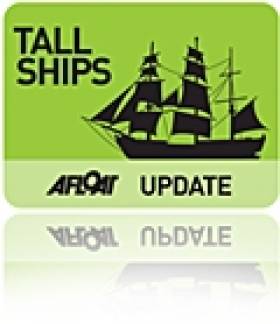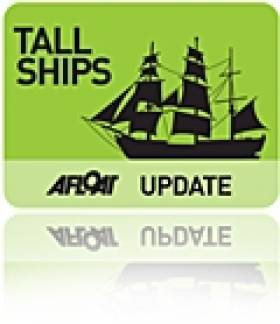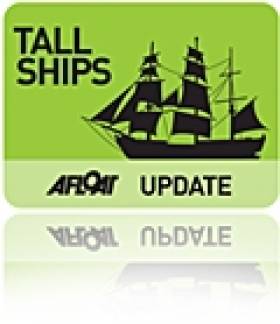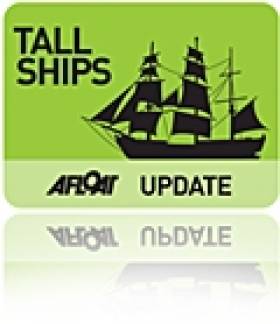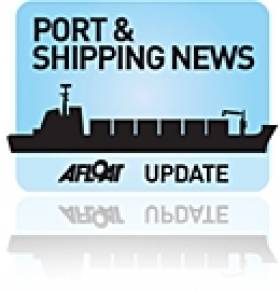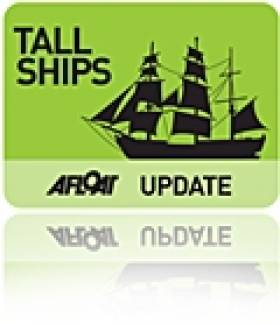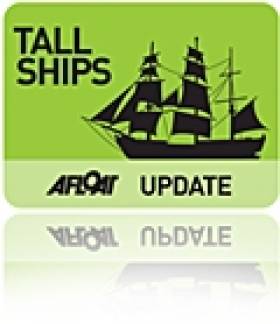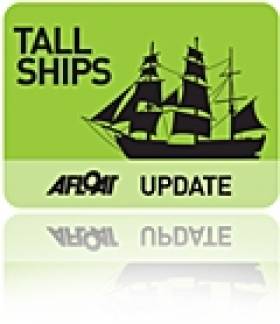Displaying items by tag: TallShips
Tallship For All Follows In Wake of MOD70 City Races
#TALL SHIP- The UK flagged tallship Lord Nelson, built specifically to enable people of all physical abilities to sail side-by-side as equals, last night anchored off Scotsman Bay. It was in these inshore waters recently where the impressive MOD70 'City' Races took place off Dun Laoghaire Harbour's East Pier, writes Jehan Ashmore.
The barque is run by the charity, Jubilee Sailing Trust (JST), and she followed in the wake of another albeit smaller tallship, Vilma, which too had anchored in Scotsmans Bay, though much closer to the shoreline. The Welsh schooner registered in Beaumaris, was in the flotilla with spectators to witness the MOD70s as the high-tech 'Formula 1' of boats belted across Dublin Bay.
JST also own another barque, the Tenacious, and both vessels are regular callers to Irish ports, where they provide sailing holidays for everyone to experience the thrill and adventure of life at sea and get involved in almost every activity on board. This can involve taking the helm, setting the sails and keeping watch, regardless of physical ability and previous sailing knowledge.
For details of voyages around the UK and Ireland click HERE, noting the vessels also cruise in far distant waters. For example Lord Nelson is scheduled to depart on a voyage from Kochi in India next year.
Norwegian School Tallship to Make Return Call to Capital
#TALL SHIP -The Norwegian three-mast school ship Christian Radich is to visit Dublin Port tomorrow as part of a four-day stopover, writes Jehan Ashmore.
The 1937 built tallship will make her main port of call to the capital during a four week sailing programme arranged by Norwegian Navy Officer Candidate School.
She called to Dublin Port last year, as previously reported on Afloat.ie for publicity purposes in advance of this year's successful festival in the capital which was host to the final port of call of the Tall Ships Races. Likewise of the tallships, she is to berth alongside the Liffey at Sir John Rogersons Quay.
For further details of the tallship whose homeport is Oslo and also the principle characteristics of the vessel click this LINK.
Ports & Shipping Review: New Tallships Race and Cruise Operators, Superpower Naval Visitors, School at Sea, Irish Sea Excursions and Wind-Farms
#PORTS & SHIPPING REVIEW - Over the last fortnight Jehan Ashmore has reported from the Shipping scene where after the Irish Navy's role in the Tallships 'Parade of Sail', the inaugural Irish Sea Tall Ships Race finally got underway to Liverpool.
Also making a call to Dublin Port was cruise newcomer Plantour & Partners's whose small cruiseship Hamburg made her debut visit to the capital port.
The following day saw the classic cruiseship veteran Princess Daphne call, she was launched originally as a general cargo-ship serving the UK-Australia and New Zealand trade routes. In the same week her sister Princess Danae was arrested in Dublin Port, for an alleged non-payment of fuel bills. The dispute was eventually settled which saw the H&W built vessel depart for La Rochelle.
Operating profits at Irish Ferries of €3.2m for the first six months of 2012, remained the same compared to the same period last year, according to its parent company ICG which released its financial interim report.
A special call by the USS Fort McHenry (LSD-43), a dock landing ship to Dublin Port was made to coincide with American Football Week which allowed her crew to attend the Emerald Isle Classic showdown between the Navy and Notre Dame. On a related note US students where making their 'Semester at Sea' cruise on board Explorer which had called to Galway Bay and later the capital.
With the US Navy in Dublin, the rebel county had its own rare visit of the Russian Navy, when the destroyer Vice-Admiral Kulakov (626) called to Cobh. On both occasions the public were able to board.
Glasgow based Waverley Excursions have been running several unusual route excursions out of Northern Ireland. The final excursion was scheduled for today with a day-trip between Portaferry, Co. Down and Peel on the west coast of the Isle of Man.
While on waters off the east coast of the Irish Sea's largest island, proposals for an extended wind-farm will not require re-routing of shipping lanes according to developer Dong Energy. They operate the Walney Island wind-farm off Cumbria.
Grand Old Lady of the Sea Belém Visits Galway
#TALLSHIP GALWAY – Not all tallships visiting Irish waters were concentrated in Dublin Port for the successful tallships festival, as the French three-masted barque Belém, built in 1896, docked into Galway Harbour last week, writes Jehan Ashmore.
She moored alongside the North Dun Aengus Quay, in the single dock basin port, where the veteran vessel (116 years old!) stayed for two nights. On board were 49 trainees who had made the passage from St. Malo in Brittany.
Belém which is run by the Paris based Belem Fondation, has had a long and varied career, as previously reported on Afloat.ie.
According to Galway Harbour Master, Brian Sheridan she has had an "interesting history" trading mostly to the West Indies and Guyana before being owned by the Duke of Westminster and also by Arthur Ernest Guinness.
In recent years Belém has called to several Irish ports, with the last visit to Galway in 2007 and also to Dublin in 2010 for the inaugural French Market Festival. She also took part in the first Tall Ships Races to be hsoted in Waterford in 2006.
She has also been involved in transporting commercial quantities of wine between Bordeaux and Quebec and also on a publicity wine-trade marketing visit to Dublin, prior to her call in 2010.
Dublin’s Tallship Link to Parade of Sails Naval (Guard) Ships
#TALL SHIPS – At the Dublin Tall Ships Races Festival, the docklands-based replica 19th century barque Jeanie Johnston was open to the public, however a former Irish Naval Service vessel, could of been there in her place, had circumstances in the past had taken a different course, writes Jehan Ashmore.
Since 2005, the Jeanie Johnston has been owned by the Dublin Docklands Development Authority (DDDA) which as part of its remit was to regenerate water-borne activity along the Liffey. In May this year it was announced the authority is to be wound-down over a period of 18 months.
The Jeanie Johnston currently serves as a static floating emigrant famine museum. This is a stark contrast to when the barque made a historic re-enactment voyage in 2003 of her predecessor which carried Irish emigrants across the Atlantic, between 1845-1855 to Quebec, Baltimore, and New York.
Prior to the acquisition of Jeanie Johnston by the DDDA, the L.E. Deirdre (P20) was decommissioned four years previously when the Naval Service put her up for auction. She is an elder half-sister of the L.E. Emer (P21) which performed 'guardship' duties during last Sunday's Parade of Sail off Dun Laoghaire Harbour.
Notably the L.E. Deirdre is historically significant in that she was the first custom-built newbuild for the Naval Service and also the first such vessel built in the country, at Verolme Cork Dockyard in 1972, however despite campaigns to keep her as part of our national maritime heritage, this did not materialise, as she was sold at a bargain price of £180,000 to a UK company.
Initially this saw the vessel go to the ship-repair yard of Pomerania, in Szczecin, ironically the Polish city which was the presenting sponsor of the Dublin Tall Ships Races Festival in association with Sail Training International (STI).
However the owner of the former Naval Service vessel, died in 2004, and work on transforming the offshore patrol vessel into a luxury charter yacht, which included installing a helicopter landing pad, came to a standstill. She was sold again and towed to Brazil in 2005 where it is believed the 220ft vessel renamed Santa Rita, painted beige replacing the dull naval grey, was to be completed in 2010.
Yesterday L.E. Emer departed Dublin Port to resume routine patrols and the last large tallship to bid the capital farewell, the A-class, Italian Navy's Amerigo Vespucci, was underway last night. This leaves the Swedish Navy's gaff schooner Falken (class-B) as the last of the tallships still in port.
Irish Sea Tall Ships Regatta is Finally Underway
#TALLSHIPS – As previously reported on Afloat.ie, the first Irish Sea Tall Ships Regatta, which was postponed on Sunday due to adverse weather, set off yesterday afternoon from Dun Laoghaire Harbour, writes Jehan Ashmore.
The majority of the 11-strong fleet did not return to Dublin Port after the Parade of Sail, but instead took shelter in Dun Laoghaire Harbour. This gave curious onlookers in the harbour an opportunity to see the vessels up close and personal, as they berthed alongside Carlisle Pier. The inaugural race consists only of a single leg and that is to Liverpool.
Among the fleet were the Dutch gaff schooner De Gallant, and three UK vessels, the ketch Maybe, the barquentine Pelican of London and another gaff schooner Johanna Lucretia. Several years ago the 96ft vessel built in 1945, had replaced the original vessel used in the RTE reality show 'Cabin Fever' after the Camaret of Cornwall, ran aground off Tory Island, Co. Donegal.
Ports & Shipping Review: Port of Cork, Cruiseships, Tallships, Museum Mondays, Shipping Cranes, Newbuilds, Ferries and Detentions
#PORTS & SHIPPING REVIEW - Over the last fortnight Jehan Ashmore has reported from the Shipping scene where the Port of Cork Company posted an operating profit before exceptional costs of €1.3 million – down by €700,000 from 2010 – on a turnover of €21.4 million.
Dublin Port welcomed a new cruise operator, MSC Cruises when the 59,000 tonnes MSC Lirica made her maiden 'Irish' port of call, which was followed by visit to Cobh in mid-August. On the same day of MSC Lirica's call to the capital, P&O Cruises Adonia became the second caller so far this season to Foynes on the Shannon Estuary.
The luxury liner returned to Dublin yesterday, coinciding with The Tall Ships Race Festival and where today the fleet set off with the highlight of the 'Parade of Sail' which passed off Dun Laoghaire Harbour and Howth Peninsula. The Ecuadorian Navy's barque Guayas lead the parade, as they sailed past the anchored guardship L.E. Emer offshore of the harbour mouth.
For the first time the National Maritime Museum of Ireland in Dun Laoghaire, broke tradition by opening its doors to the public on Mondays, and this will remain so to the end of the summer.
The heavylift cargo-ship HHL Valparasio (2010/17,634grt), believed to be the largest vessel ever to dock in Fenit, Co. Kerry, loaded two ship-to-shore container cranes built by the Liebherr factory outside Killarney, which were bound for the Elizabeth Port, New Jersey in the US.
Also in the same county, the luxury 5-star cruiseship Hebridean Princess was on a 7-night cruise tour of the south-west coast based out of Cobh, where passengers had flown in from the UK. The cruise was unusual in that the ports were all concentrated in that region.
Also based out of Cork is the headquarters of Ardmore Shipping Ltd, whose first of four product tankers was marked by a keel-laying ceremony at a South Korean shipyard.
Single-route operator Celtic Link Ferries chartered ro-pax Celtic Horizon, is running her first peak-season sailings since introduced on the Rosslare-Cherbourg route in October last year.
During this week the Naval Service detained an Irish registered trawler in relation to alleged breaches of technical fishing regulations offshore of Ballycotton. The OPV L.É. Niamh (P52) escorted the vessel to Cork. This followed another detainment off Ballycotton and again an Irish trawler, for the same reasons, when the CPV L.É. Ciara (P42) escorted the vessel also to Cobh.
Dublin Tall Ships ‘Parade of Sail’ Gun Salute Relocates from Dun Laoghaire Harbour to Poolbeg
#PARADE OF SAIL UPDATE– A gun salute for today's Dublin Tall Ship Festival climax of the 'Parade of Sail' will now take place at Poolbeg in Dublin Port, rather then Dun Laoghaire Harbour as previously reported, however the tallships will remain on a course to pass off the harbour entrance, writes Jehan Ashmore.
The first tallship to bid Dublin farewell, is to depart at 11.00 this morning, and once they pass the Poolbeg Lighthouse, they will then proceed on a course heading for Dun Laoghaire Harbour. Noting the first tallship is expected to pass off the harbour around 11.45am and the last ship is due around 2.15pm.
Awaiting the fleet in Dublin Bay will be the Naval Service OPV L.E. Emer (P21) which will be anchored north north-east (0.5miles) off the East Pier, Dun Laoghaire Harbour. The tallships will round pass the L.E. Emer and then change course by heading for the Dublin Bay Buoy in the centre of the bay and head for the Baily Lighthouse on Howth Peninsula.
There will vantage points throughout the coastline of Dublin Bay, with the South Wall in Dublin Port, the west and east piers of Dun Loaghaire Harbour and along Howth Peninsula, been particularly good locations to witness what should no doubt be a memorable day as these glorious ships of sail head off over the horizon to many a distant shore.
When the fleet arrives off Howth Peninsula, they will divide into two, as 11 tallships will gather to form a smaller fleet which are to take part in the inaugural Irish Sea Tall Ships Regatta. This new event sees these tallships racing between Dublin to Liverpool.
‘Irish’ Tallships Are Thin and Small On the Sea-Ground
#IRISH TALLSHIPS – Of the 40-plus tallships participating in the Dublin Tallships Race Festival, only two vessels are Irish, and as previously reported on Afloat.ie, there have been calls to have a new cross-border national sail training flagship reinstated, writes Jehan Ashmore.
What represents Ireland, are not large A-class tallships but smaller vessels in the form of the Naval Reserve training Bermuda ketch STV Creidne (C-class) and the Kinsale based schooner Spirit of Oysterhaven (D-class), which sailed through Dalkey Sound yesterday morning.
It is a stark contrast to the glory days of when the Irish tallships, met together for a historic first and only gathering at the inaugural Waterford Tall Ships Race Festival back in 2006. The tallship trio were brigantine Asgard II (which sank in 2008) and the barques Dunbrody and Jeanie Johnston.
The unique gathering took place during the 'Parade of Sail' in Waterford Estuary, where Asgard II was given the honour in leading the fleet, followed by her fellow Irish fleetmates and the rest of the international flotilla.
Both the replica 19th century Dunbrody and Jeanie Johnston remain in a static role in New Ross, Co. Wexford and in Dublin Docklands, where they serve as floating museums, telling the story of emigration and the famine ships.
During the Dublin Tallships Festival, the Jeanie Johnston will be open to the public free of charge throughout the weekend from 10am to 5pm (last entry) and is on a first come first basis.
Entry to the barque is courtesy of Dublin Docklands Development Authority which purchased the vessel in 2005. For further information visit: www.jeaniejohnston.ie/index.html
More Big Tallships Due for Start of Dublin’s Sailing Spectacle
#TALLS SHIPS – So far some 30 vessels of the 43 strong-fleet are berthed along the Liffey quays and the remainder of the fleet including some of the largest and most impressive A -class tallships are due tomorrow, writes Jehan Ashmore.
They include the Mexican Navy's sail training barque Cuauhtemoc (built 1982, length: 90m), the full-rigged ship, Amerigo Vespucci (built 1931, length 102m) also used for the same purpose operated by the Italian Navy.
Their arrival tomorrow, will certainly add to the exciting atmosphere as the first of the four-day free family festival begins. The festival is billed as the biggest festival event in Ireland, which is expected to draw an estimated 1 million visitors. An excellent opportunity to see these wonderful ships of sail is by taking the Allianz All-Aboard Liffey Cruise, with seats available for just €1!
One of the festival programme highlights will be the 'Crew Parade' (Friday August 25th), when 1,500 sailors are to walk through the city to a prize giving ceremony.
The weekend will culminate in spectacular fashion with the 'Parade of Sail' (Sunday August 26th) when all the ships leave port together with their graceful sails hoisted. For details of the action packed festival sponsored by the Polish port city of Szczecin and organised by Sail Training International visit: www.dublintallships.ie
It's nearly a week since the final Tall Ships Race leg was completed between Coruna and off Tuskar Rock Lighthouse, albeit in very stormy conditions with torn sails and even broken masts.
Having said that the weather has greatly improved with more sedate seas in which the tallships dispersed to ports Arklow, Dun Loaghaire, Howth, Wicklow and Waterford, last year's host port of the famous race and where in 2006 the crystal city first welcomed the fleet.
In recent days batches of tallships, of all shapes, sizes and classes have descended into Dublin Bay. Larger tallships tended to take a route via the Kish Bank, whereas medium and smaller classes clung along the Leinster coast and some made a transit through Dalkey Sound.
As of this afternoon, the Naval Service L.E. Emer (P21) provided escort duties as several vessels made passage parallel to the east coast and later docked in the cities 'docklands' quarter.
Among the arrivals were:
Danmark (class: A, rig: built: 1933, length: 74m) De Gallant (class B,rig: Gaff Schooner, built 1916, length: 36m) and Challenge Wales (Class C, Rig: Cutter, built: 2000, length: 22m)
The latest arrival came this evening with the Jubilee Sailing Trust's Lord Nelson, she is one of only two such sailing vessels in the world designed to accommodate both disabled and abled bodied sailors , for more details visit www.jst.org.uk
She had anchored off Wicklow before heading along the coast this afternoon, where she called into Scotsmen's Bay of Dun Laoghaire, albeit briefly and then headed for the short passage to the capital.


























